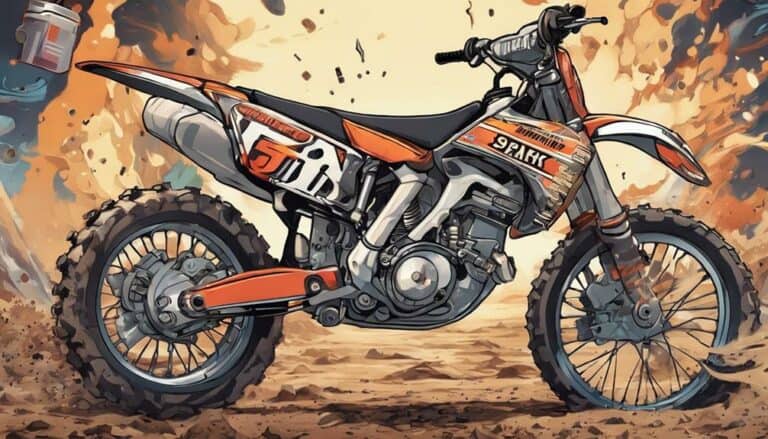When it comes to locating the spark plugs on a dirt bike, you might initially feel a bit puzzled by their placement. However, understanding the importance of these small yet crucial components is key to maintaining your bike's performance.
So, where exactly are these spark plugs situated on your dirt bike? Let's shed light on their elusive location and unravel the mystery behind their role in your bike's engine functionality.
Key Takeaways
- Spark plugs are located near the top of the engine cylinder head.
- Look for a rubber spark plug wire leading to the plug.
- Accessing instructions in the bike manual is crucial for locating the spark plug.
- Proper maintenance, removal, cleaning, and installation are essential for optimal dirt bike performance.
Importance of Spark Plugs
Spark plugs play an important role in the ignition system of a dirt bike's engine, conducting electrical current to generate the spark necessary for combustion. Regular maintenance of spark plugs is vital for the overall health and performance of your dirt bike.
Neglecting spark plug maintenance can lead to various issues such as poor engine performance and starting difficulties. By ensuring that the spark plugs are in good condition, you can optimize your engine's efficiency and power delivery.
Proper maintenance involves inspecting the spark plugs regularly for signs of wear or damage, such as fouling or electrode erosion, and replacing them when necessary. Additionally, checking and adjusting the spark plug gap according to the manufacturer's specifications is essential for proper ignition timing.
Ignoring the maintenance of spark plugs can result in costly engine damage and decreased overall performance of your dirt bike. Remember, taking care of your spark plugs is key to keeping your engine running smoothly and efficiently.
Understanding Spark Plug Function
Located at the top of the engine cylinder head, spark plugs are essential components positioned within the combustion chamber to facilitate ignition. These small but powerful devices have been around for over 100 years, serving as the ignition source for internal combustion engines.
When you need help starting your dirt bike, the spark plug plays a vital role by producing the spark necessary to ignite the air-fuel mixture. As the piston compresses this mixture within the combustion chamber, the spark plug generates a high-voltage electrical current that jumps the spark plug gap, creating a spark.
This spark ignites the compressed air-fuel mixture, initiating the combustion process that powers your engine. Without a properly functioning spark plug, your engine may misfire, have difficulty starting, or experience reduced performance.
Regularly checking and replacing spark plugs, which are relatively inexpensive, is crucial to ensure optimal engine performance and reliability.
Locating the Spark Plug
Positioned near the top of the engine cylinder head, you can typically find the spark plug on most dirt bikes. Look for a rubber spark plug wire leading to the spark plug, usually accessible under the fuel tank or seat. Consulting the bike manual for the exact location and accessing instructions is important for proper maintenance and replacement. Here's a table to summarize key aspects of spark plug maintenance:
| Maintenance Task | Description | Importance |
|---|---|---|
| Troubleshooting Issues | Diagnosing and fixing problems like misfiring or poor performance. | Ensures ideal engine function. |
| Cleaning Spark Plug | Removing carbon deposits and dirt to maintain spark efficiency. | Prevents potential misfires. |
| Upgrading Spark Plug | Replacing with a higher quality or performance-oriented plug. | Enhances engine power output. |
Removing the Spark Plug
Using a spark plug wrench, disconnect the wire attached to the spark plug near the top of the engine cylinder head.
Before proceeding, confirm there's no dirt or debris that could fall into the cylinder upon removal.
For maintenance tips, inspect the spark plug for wear, damage, or fouling. Troubleshooting steps include checking the color and condition of the electrode and insulator.
To remove the spark plug, carefully twist it counterclockwise using the spark plug wrench until loose. Then, gently unscrew it by hand.
Cleaning techniques involve using a soft brush to remove any carbon deposits. Avoid using excessive force to prevent damaging the threads.
Remember, a properly maintained spark plug is essential for peak engine performance.
Stay vigilant during removal to prevent any contaminants from entering the combustion chamber.
Installing a New Spark Plug
To guarantee proper installation of a new spark plug on your dirt bike, handle the spark plug with caution to avoid damaging the electrode. Here are some steps to make sure a successful installation:
- Gently place the spark plug in the socket to avoid damaging the electrode.
- Don't force or overtighten the spark plug during installation to prevent potential damage to the threads.
- Confirm correct positioning and alignment of the spark plug in the socket before tightening it with a socket wrench for a secure fit.
- Avoid over-inserting the spark plug into the socket to prevent any issues with the combustion process in the engine.
- Carefully follow the manufacturer's guidelines for installing a new spark plug to maintain top engine performance and longevity.
Following these steps will help you with spark plug maintenance, troubleshooting spark plugs, and upgrading spark plugs on your dirt bike effectively. Proper installation is key to making sure your bike runs smoothly and efficiently.
Conclusion
Now that you know where spark plugs are located on a dirt bike and how important they're for ignition, remember to regularly inspect and maintain them.
Like a well-oiled machine, a dirt bike with properly functioning spark plugs will run smoothly and efficiently.
Ignoring spark plug maintenance is like driving a car with a flat tire – it may still move, but not as effectively or safely.
Keep those spark plugs in top condition for the best performance.

